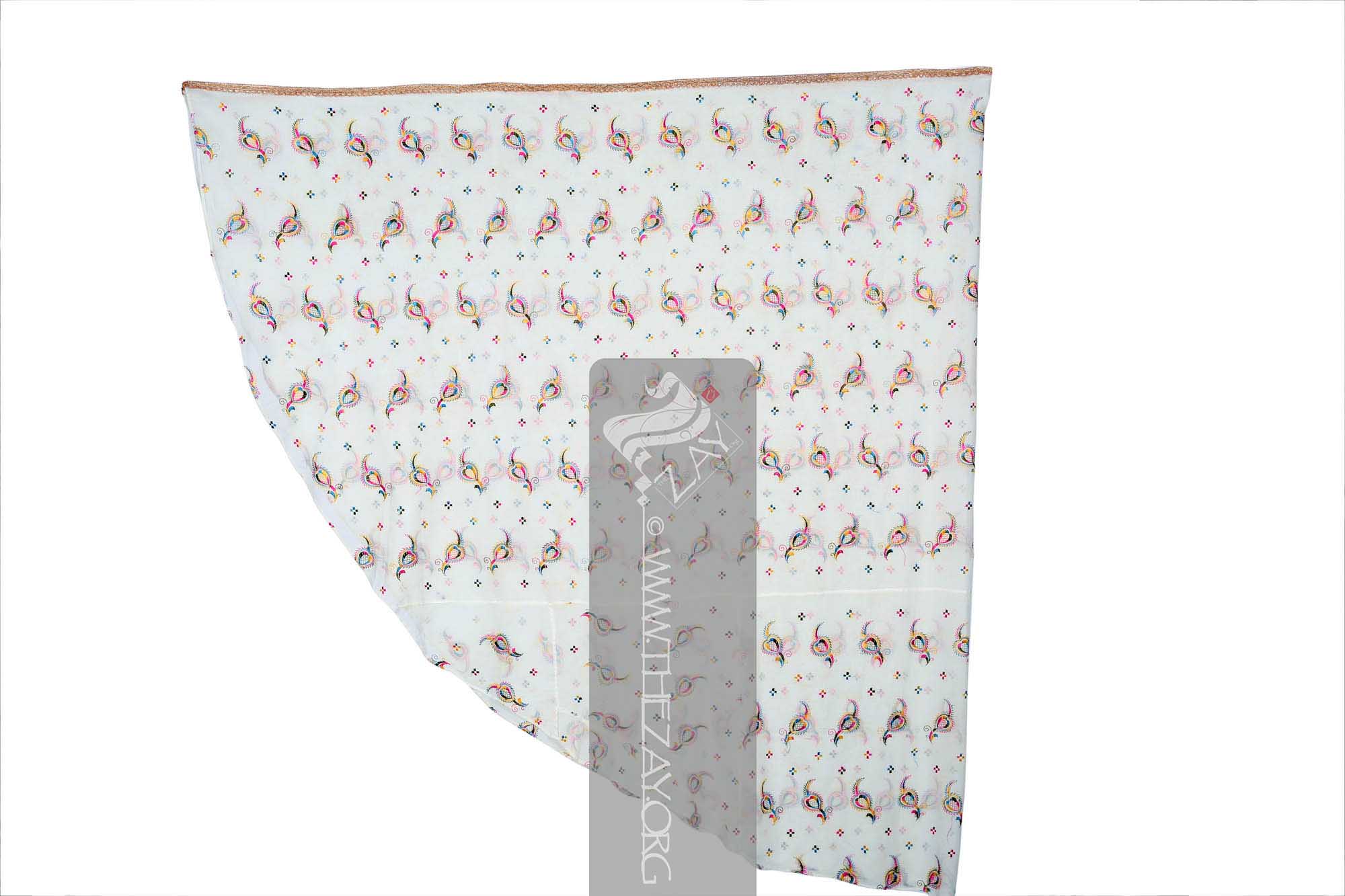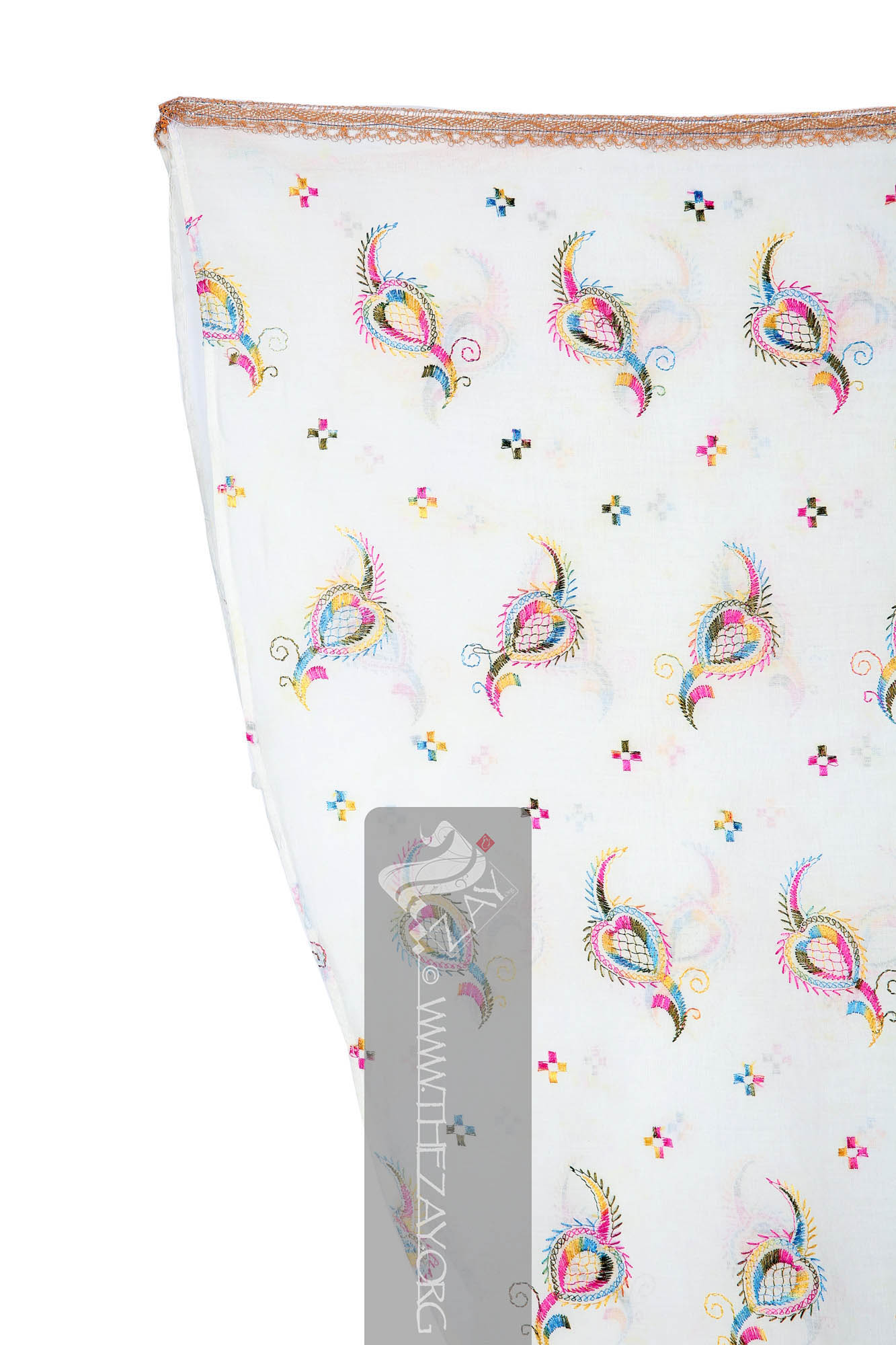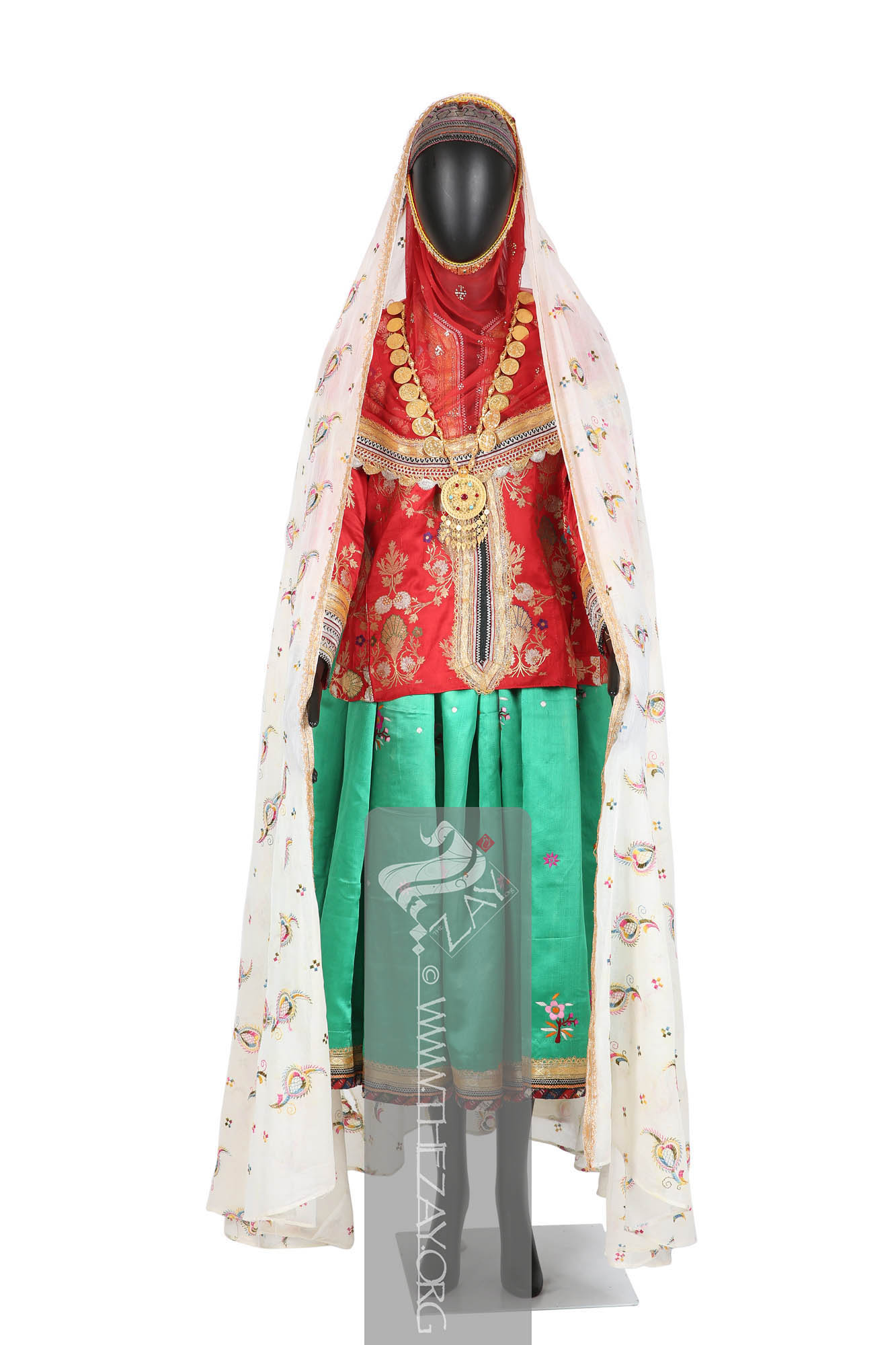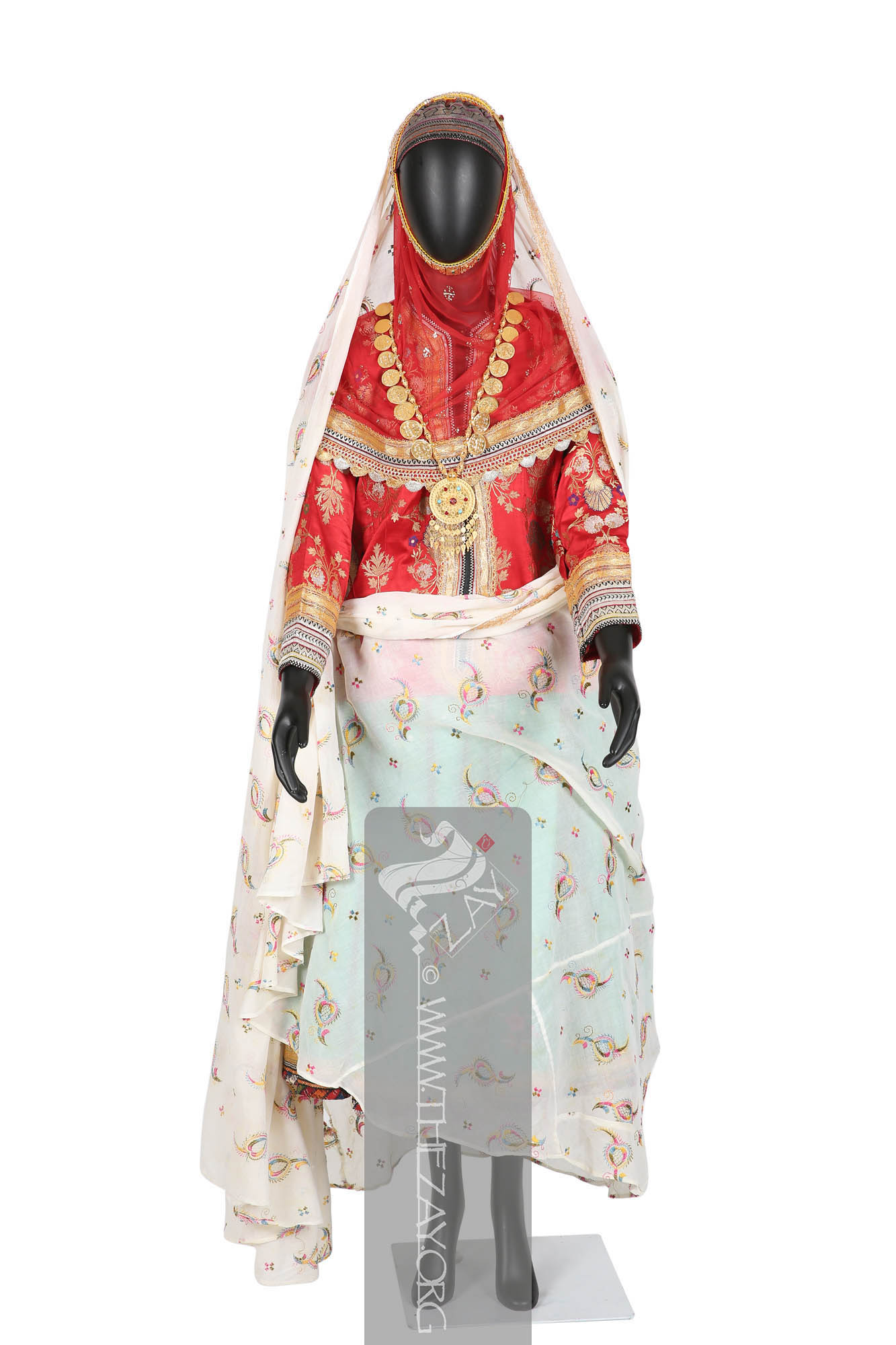







| Local Name | Chador |
| Object Category | Cloak |
| Gender | Female |
| Place Of orgin | Asia |
| Region | Evaz |
| Object Range | Iran, Pakistan, Afghanistan, India |
| Dimensions | Length: 314 cm Width: 195 cm |
| Materials | Silk Cotton |
| Technique | Hand Stitched Hand Embroidered |
| Motif | Floral |
| Provenance | Purchased, Homiera Ebadi, Iran 2018 |
| Location | The Zay Zay: (Arabic: costume, Pl. azyaā’), a set of clothes in a style typical of a particular country or historical period. Initiative |
| Status | In Storage |
| ZI number | ZI2018.500738 ASIA |
Ṭariq: (Arabic; Synonym: tulle_bi_talli
Tūlle_bi_tallī: (French: Tulle – a city in France where fine material for veil was first made; Turkish: tel – wire; Synonym: tariq; talli; badla; khus_dozi ), series of small metal knots made on a woven net ground as embellishment. The term is commonly used in the North African Arab region specifically in Egypt.
Ṭariq: (Arabic; Synonym: tulle_bi_talli
Tūlle_bi_tallī: (French: Tulle – a city in France where fine material for veil was first made; Turkish: tel – wire; Synonym: tariq; talli; badla; khus_dozi ), series of small metal knots made on a woven net ground as embellishment. The term is commonly used in the North African Arab region specifically in Egypt.
Dupatta: (Sanskrit: du – double or twin and patta – a piece of cloth or shash), a portmanteau of the two Sanskrit words it means a head scarf Scarf: (English), usually a rectangular piece of cloth loosely worn over the shoulders, upper body and arms, and sometimes also over the head. doubled as a wrap used by women in the Indian subcontinent for modesty and is an essential part of their everyday ethnic garments.
).Chādor: (Persian: a tent), a long cloak like body cover similar to the (Abayah), traditionally worn by southern Iranian women of Hormozgan. Similar to the Afghan chadri, however these do not have a netted veil covering the face of the wearer.) with repeats of floral motifs executed in (satin Sātin: (Arabic: Zaytuni: from Chinese port of Zayton in Quanzhou province where it was exported from and acquired by Arab merchants), one of the three basic types of woven fabric with a glossy top surface and a dull back. Originated in China and was fundamentally woven in silk. _stich) style embroidery in a variety of coloured silk floss Floss: (Old French: flosche – nap of velvet), is a type of silk fibre obtained from the cocoons of wild silkworms. It is characterized by its long, fluffy fibers that are not tightly woven, making it ideal for use in various textile applications such as embroidery, lace-making, and sewing. threads – green, blue, yellow, and fuchsia pink. It is constructed of four pieces of fabric sewn together.Dupatta: (Sanskrit: du – double or twin and patta – a piece of cloth or shash), a portmanteau of the two Sanskrit words it means a head scarf Scarf: (English), usually a rectangular piece of cloth loosely worn over the shoulders, upper body and arms, and sometimes also over the head. doubled as a wrap used by women in the Indian subcontinent for modesty and is an essential part of their everyday ethnic garments.
).Chādor: (Persian: a tent), a long cloak like body cover similar to the (Abayah), traditionally worn by southern Iranian women of Hormozgan. Similar to the Afghan chadri, however these do not have a netted veil covering the face of the wearer. belonged to a Lori ethnic woman or a Qashqai. While the Loris are known for not wearing chador shādor: (Persian), a cloak in the form of a large semi-circle cloth without sleeves, worn by women in Iran and Iraq draped over their head to cover the full length of their body in public. It functions just as the (abayah) of the Arab region. In South Asia the word (chador) usually refers to a shawl Shawl: (Persian: shāl from Hindi: duśālā – Shoulder Mantle), a shawl is a South Asian version of a scarf worn or wrapped loosely over the shoulders and is usually made of wool. like garment resembling a (dupattaDupatta: (Sanskrit: du – double or twin and patta – a piece of cloth or shash), a portmanteau of the two Sanskrit words it means a head scarf Scarf: (English), usually a rectangular piece of cloth loosely worn over the shoulders, upper body and arms, and sometimes also over the head. doubled as a wrap used by women in the Indian subcontinent for modesty and is an essential part of their everyday ethnic garments.
).Chādor: (Persian: a tent), a long cloak like body cover similar to the (Abayah), traditionally worn by southern Iranian women of Hormozgan. Similar to the Afghan chadri, however these do not have a netted veil covering the face of the wearer. more often than none even today, except in recent years that too while visiting more urban areas, the Qashqai women did practice wearing chador shādor: (Persian), a cloak in the form of a large semi-circle cloth without sleeves, worn by women in Iran and Iraq draped over their head to cover the full length of their body in public. It functions just as the (abayah) of the Arab region. In South Asia the word (chador) usually refers to a shawl Shawl: (Persian: shāl from Hindi: duśālā – Shoulder Mantle), a shawl is a South Asian version of a scarf worn or wrapped loosely over the shoulders and is usually made of wool. like garment resembling a (dupattaDupatta: (Sanskrit: du – double or twin and patta – a piece of cloth or shash), a portmanteau of the two Sanskrit words it means a head scarf Scarf: (English), usually a rectangular piece of cloth loosely worn over the shoulders, upper body and arms, and sometimes also over the head. doubled as a wrap used by women in the Indian subcontinent for modesty and is an essential part of their everyday ethnic garments.
).Chādor: (Persian: a tent), a long cloak like body cover similar to the (Abayah), traditionally worn by southern Iranian women of Hormozgan. Similar to the Afghan chadri, however these do not have a netted veil covering the face of the wearer. but very casually until the revolution. Although they did relent to a degree to the new dress code after the formation of the Islamic Republic of Iran and have adopted the dark-coloured chador shādor: (Persian), a cloak in the form of a large semi-circle cloth without sleeves, worn by women in Iran and Iraq draped over their head to cover the full length of their body in public. It functions just as the (abayah) of the Arab region. In South Asia the word (chador) usually refers to a shawl Shawl: (Persian: shāl from Hindi: duśālā – Shoulder Mantle), a shawl is a South Asian version of a scarf worn or wrapped loosely over the shoulders and is usually made of wool. like garment resembling a (dupattaDupatta: (Sanskrit: du – double or twin and patta – a piece of cloth or shash), a portmanteau of the two Sanskrit words it means a head scarf Scarf: (English), usually a rectangular piece of cloth loosely worn over the shoulders, upper body and arms, and sometimes also over the head. doubled as a wrap used by women in the Indian subcontinent for modesty and is an essential part of their everyday ethnic garments.
).Chādor: (Persian: a tent), a long cloak like body cover similar to the (Abayah), traditionally worn by southern Iranian women of Hormozgan. Similar to the Afghan chadri, however these do not have a netted veil covering the face of the wearer. as part of their costume in the urban areas, nomadic Qashqai tribes are sometimes known for defying the revolutionary guards and their enforced changes.